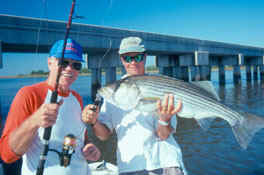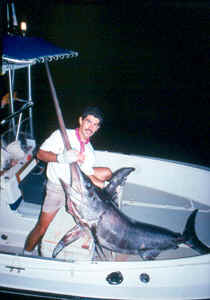
The news of an exceptionally big fish taken on incredibly light line has a way of capturing people's attention. Regardless of whether the amazing catch is a brute of a striped bass, tarpon, tuna, cobia or billfish, some people can't understand how it's possible to land a fish that weighs more than five, six or even ten times the breaking strength of the fishing line. However, it can be done, given some careful planning, the right equipment, and skill.
Specialized Tackle - For general light-tackle fishing with two-, four-, eight- and 12-pound line, choose a rod with enough backbone to put some pressure on your quarry, yet one that's light enough not to break the fishing line. For instance, to wear out small to medium-sized, long-running fish like bonefish, false albacore, bonito, mackerel and the like, some anglers prefer a 6 1/2- to 7-foot, light-action stick that's built especially for the respective line class. Those seeking larger, stubborn fish such as tunas, billfish, striped bass, tarpon, and halibut favor slightly shorter, medium-to-heavy-action blanks, some which are even rated for a heavier line class than the line being fished. The rod tips should be sensitive enough to absorb sudden surges, and the guides must be kept in immaculate condition. The exact rod specifications will vary dramatically depending on the species be pursued and the water depth.
Naturally, reels should hold enough line to handle the target species. Don't overdo it, however. Some anglers believe that by filling a large, high-capacity reel with a thousand-plus yards of ultralight line, they'll prevent a big fish from stripping them and tire it out in the process. That's not how the game is played. The goal is to keep the fish as close to the boat as possible by following it, not to remain stationary. Therefore, the reel's line capacity need only be large enough to keep the angler from being spooled should a fish head straight for the bottom. The reel should be small and light enough to comfortably hold and manage throughout the fight.

If you're seeking records, spool up with an IGFA-class line, which will part at or slightly less than its rated breaking strength. On the other hand, if setting a line-class record isn't important to you, a premium grade of line should provide more durability and forgiveness when pressuring a fish, since they often part above their rated breaking strengths. Regardless of your choice, fill the reel to capacity and replace the line after fighting a large fish, even if it still looks and feels like new. Always carry several spare spools or reels, which can be quickly substituted.
Leader lengths should be based on the species and what you're trying to accomplish. Record-seekers must be sure the leader length and any double line conforms to IGFA specifications. The current specifications state that the combined length of the double line and leader shall not exceed 20 feet for all line classes up to and including 20-pound test, and 40 feet for line classes over 20-pound test. Think in terms of protecting the light fishing line from the tail of the fish while it's running, and its body, should it fall on the line after a jump. Also, factor in potential damage caused by structure such as ledges, sea fans, bridge pilings, etc.
Because of the limited pressure ultralight line exerts on a leader, it's not necessary to use a heavy one. While a 100- to 125-pound monofilament leader is commonly used on 30- and 50-pound tackle when trolling for offshore game fish such as dolphin, tuna and billfish, for example, a 40- to 60-pound leader is sufficient for these species on four-, eight-, 12- and 20-pound gear. To visualize this, think in terms of stretching a length of string between your hands. When you pull very tightly and create a lot of tension, one slight touch of a sharp knife will sever the string. However, if you reduce the tension, more of an effort will be required to cut it.
Lighter mono and Fluorocarbon leaders are also smaller in diameter and less visible, which may lead to more strikes. With metal leaders, choose the lighter ones as well, which slide more easily through a fish's jaw and increase the chance of a solid hook-set. Use knots that preserve your tackle system's strength, such as a Bimini twist (double line), Bristol knot (mono-to-mono leader connection) and Albright special (mono-to-wire connection).
Hook Logic - One question that always arises in light-line fishing is "how can you set the hook on a big fish with such light tackle?" One trick that was shown to me nearly two decades ago by a few light-tackle anglers centered on hook selection and sharpening. Fishing with tackle as light as six-pound test, these pros would use small, fresh water hooks that were formed from ultra-thin wire. The concept was, and is, simple: a light-wire hook takes far less effort to sink into a fish's jaw compared to a larger, heavier model. The same applied to lures. They went one step further by placing the hook upside-down in a vice and filing the backside of the point to a razor finish. When a fish clamped down on the hook, the outer edge began cutting into the flesh, thereby facilitating the penetration of the point and barb. Between the light-wire fabrication and outer-edge sharpening, positive light-tackle hook-sets became elementary. Fortunately, today's line-up of salt water hooks features models in all sizes and diameters, many of which are chemically sharpened. However, choose the smallest and lightest hook you can get away with, and consider sharpening the outer point. It works!
Striking The Iron - Setting the hook on light tackle involves a certain discipline. Instead of instinctively reeling in line, rearing back several times, and hunkering down for a slugfest, your goal is to quickly take up slack and, either by cupping or thumbing the reel spool or advancing the drag lever, apply just enough extra pressure to hook the fish. It's a game of timing and feel, because the pressure must be eased as soon as the fish surges, or you'll break the line. In many situations, fish are teased or chummed to the boat before they're presented with a bait on light tackle. Striking a fish close to the boat enables an angler to apply maximum pressure, as opposed to trying to set the hook on a fish that has taken the bait or lure far back in the spread. It also helps the captain follow the fish. Chasing the fish allows the angler to keep an excessive amount of line out of the water, subjecting it to less strain and threats from flotsam and structure. If the captain is slow in catching up to a fish that's notorious for sounding, or the boat remains stationary, the line could part on a shelf, wreck, ledge, reef or other type of high-profile bottom structure. Staying directly above a sounding fish will keep the angle of the fishing line nearly vertical, where it's less likely to come in contact with these obstructions. The same applies to fighting inshore fish such as bonefish and permit. After the hook-up, the rod should be held high overhead while the skiff follows the fish off the flats and into deeper water.

The Fight - Most light-tackle fighting drags are set at less than 1/5 of the line's rated breaking strength. For example, a maximum of one-half pound of drag for four-pound line, 1 1/2 pounds of drag for eight pound test line, etc. The key is to initially let the fish run and expend its energy, rather than pressuring it from the start. However, the longer the battle lasts, the greater the chances of losing the fish. Even a skilled light-tackle angler with the best equipment has a certain window in which to land his fish before the fishing line and leader deteriorate to dangerous levels. After the hook is set and the fish takes off, and while the helmsman is preparing for the chase, the angler should back off the drag even more. After setting the hook on a hard-charging fish such as a billfish or tuna, some anglers -- particularly those fishing four- and eight-pound line -- go into a nearly free-spool mode, relying on water resistance to keep a reasonably taught connection to the fish. Additional pressure from the reel's fighting drag at this stage could part an ultralight line. Once the boat is in pursuit and the gap between the angler and the fish is closed, the drag is advanced to its initial fighting position. At this stage, additional pressure is often applied by holding the line between the thumb and index finger (conventional reels) or feathering the spool (spinning tackle). Hold the line or spool while lifting the rod, releasing pressure to gain line on the downstroke.
During the battle, and particularly when the fish settles down, you will have established a rhythm. When the fish surges, immediately extend the rod to relieve the pressure and let it run. When the fish slows or stops, apply pressure and take up line. As the fish begins to tire, you'll need to gradually increase the pressure. Eventually, you'll have to flirt with the line's breaking strength if you want to beat the fish. Once again, it's a matter of developing a special feel for the line and tackle, and learning to anticipate the fish's movements just before they occur. A fish often becomes lulled by a certain amount of pressure and fighting rhythm, but reacts violently to sudden changes, such as when the leader is grabbed. Unless your crew is highly experienced in handling fish near the boat, this is where hooks are straightened or pulled and lines are broken. That's why wind-on leaders are so popular, since they enable the fish to be played right alongside the boat. Depending on the situation, the boat could also be used to lead the fish in. Simply head into the current during the final stages, maintain the rhythm, and the fish should follow right along.
There are countless tricks and techniques associated with light-tackle fishing, many of which are species-specific. Regardless of your experience level, it's a challenging and fun way to test your fishing skills.

